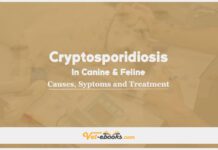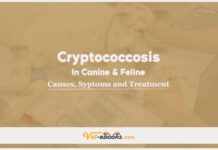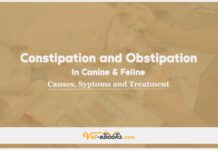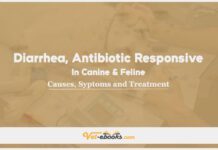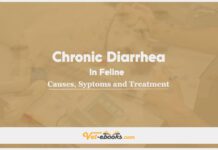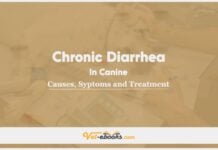Acute Abdomen In Canine and Feline: Causes, Symptoms and Treatment

Overview
Acute abdomen is a life-threatening illness marked by a painful, stiff abdomen.
Causes of Acute Abdomen In Canine and Feline
Causes
- Gastric dilatation-volvulus, ulceration, perforation, foreign body.
- Intestinal occlusion (foreign body, intussusception, mass, etc.), ulceration, perforation, enteritis, etc.
- Tearing as a result of tumor growth, blockage, ulceration, blunt or piercing trauma, or other circumstances.
- Torsion, mesenteric volvulus, or infarction-related vascular compromise.
- Pancreatic ischemia, inflammation, and abscess.
- Acute hepatitis or hepatic abscess.
- Biliary blockage, rupture, or necrosis.
- Mucocele in the gallbladder.
- Splenic abscess, thrombus, mass, and torsion.
- Urinary calculi, or tumors in the trigone area of the bladder or urethra.
- Traumatic bladder or ureteric rupture.
- Uncommon causes of acute abdomen include ureteroliths, nephroliths, acute kidney damage, and acute pyelonephritis.
- Rupture of the gravid uterus following blunt abdominal trauma, uterine torsion, ovarian tumor or torsion, and intraabdominal testicular torsion (cryptorchid).
- Prostatitis, prostatic abscess, pyometra, or ruptured pyometra can cause endotoxemia, sepsis, and cardiovascular collapse.
- Hernias with strangulated viscera in the scrotal, inguinal, peritoneal, or umbilical regions.
- Abdominal pain may result from organ displacement or entrapment in a hernia if the affected organ(s)’ vascular supply is compromised or ischemic.
Risk factors
- Gastric, duodenal, or colonic ulcers.
- Pancreatitis from consuming fatty foods or trash.
- Ingesting foreign bodies.
- Rupture of the hollow viscus due to abdominal trauma.
Pathogenesis of Acute Abdomen In Canine and Feline
- The patient feels pain because of an enlarged organ, inflammation, traction on the mesentery or peritoneum, or ischemia.
- The viscera of the abdomen are not well innervated, and it usually takes widespread involvement to cause pain.
- There are nerve endings in the submucosa-muscularis of the intestinal wall.
- Inflammation in the abdomen causes pain by releasing chemicals that activate vasoactive receptors.
Symptoms (History & Physical Examination) of Acute Abdomen In Canine and Feline
History
- Reluctance to move.
- Trembling.
- Vomiting, diarrhea, inappetence.
- Vocalizations, and unusual postures (praying position or tucked up).
Physical Examination
- Chest pain, splinting of the abdominal muscles, organs filled with gas or fluid in the abdomen, abdominal mass, ascites, pyrexia or hypothermia, tachycardia, and tachypnea.
- The middle, caudal, or cranial abdomen may be the site of the pain.
- Examine the colon, pelvic bones, prostate, urethra, and lower intestine for signs of melena.
- Exclude non-abdominal origins of discomfort by feeling the kidneys and thoracolumbar vertebrae.
- Renal discomfort may accompany pyelonephritis.
Diagnosis of Acute Abdomen In Canine and Feline
1- From History and Physical Examination
2- Diagnostic Procedures
CBC/BIOCHEMISTRY/URINALYSIS
- Leukocytosis or leukopenia.
- A neutrophilic left shift will be present in active inflammation.
- Anemia may be observed in cases of GI ulcers and blood loss.
- Prerenal, renal, and postrenal causes are linked to azotemia.
- Electrolyte abnormalities.
- Elevated hepatic enzymes and hyperbilirubinemia aid in pinpointing the source of an issue with the liver or biliary tract.
- Urine-specific gravity is required to distinguish between prerenal, renal, and postrenal issues (prior to fluid therapy).
OTHER LABORATORY TESTS
- Increased lactate may be linked to hypoperfusion, and venous blood gas measurement that includes lactate concentration may reveal problems in the acid-base balance.
- Pancreatic lipase immunoreactivity in dogs and cats helps in diagnosing pancreatitis.
Imaging
Radiography: To observe masses, morphological alterations, or organ displacement in the abdomen.
Ultrasound: To detect cysts, biliary or urinary calculi, abscesses, abdominal masses, and abdominal fluid.
CT: utilized, especially when the surgeon requires additional information preoperatively.
Abdominocentesis and Abdominal Fluid Analysis
- Perform abdominocentesis on all patients with acute abdomen.
- A four-quadrant method could increase yield. Even in cases where there is very little free abdominal fluid.
- Radiography is not quite as sensitive as ultrasound in identifying fluid, yet it can be used to guide an abdominal centesis procedure.
- Surgery should be performed immediately if an abdominal fluid investigation reveals a high white blood cell count, degenerate neutrophils, and intracellular bacteria. These findings are consistent with septic peritonitis.
- Diagnostic peritoneal lavage.
- A septic abdomen is diagnosed by measuring the glucose concentration in the abdominal effusion.
- Patients with pancreatitis experience an abdominal effusion that is classified as sterile peritonitis.
- A higher concentration of creatinine in the abdominal fluid than in the serum signifies a leak in the urinary system.
Sedation and abdominal Palpation
Useful for discovering intestinal foreign bodies that do not appear on radiographs.
Exploratory Laparotomy
When ultrasonography is unavailable or suitable diagnostics fail to identify the origin of the acute abdomen, surgery may be helpful therapeutically and diagnostically.
3- Differential Diagnosis
- Renal-associated pain, retroperitoneal pain, spinal or paraspinal pain, or conditions causing generalized muscle pain.
- Fecal parvoviral antigen assay and CBC (leukopenia) were used to discriminate between intestinal obstructive illness and parvoviral enteritis. (The two conditions might appear similarly.)
Treatment of Acute Abdomen In Canine and Feline
General
- GeneralHospitalization management involves supportive care, treatment decisions, and timely surgical intervention.
- Identifying root causes and implementing intensive therapy are crucial, especially for acute abdominal pain requiring immediate intervention.
Medications:
- Analgesic drugs may be warranted in order to manage stomach discomfort and potentially induce a state of drowsiness.
- Fentanyl intravenous bolus (at a dose of 2-5 μg/kg) followed by a constant rate infusion (CRI) (at a dose of 2-10 μg/kg/h).
- Hydromorphone (at a dose of 0.05-0.2 mg/kg with a frequency of every 4-6 hours).
- Morphine (at a dose of 0.5-2 mg/kg every 4-6 hours).
- Buprenorphine (at a dose of 0.01-0.02 mg/kg every 4-6 hours).
- Methadone (at a dose of 0.1-0.4 mg/kg every 6 hours).
- Histamine H2 Antagonists such as Famotidine (at a dose of 0.1–0.2mg/kg IV, SQ or IM q 12h) and Ranitidine (at a dose of 2mg/kg IV q 8h).
- Pantoprazole (at a dose of 0.5–1mg/kg IV as a CRI over 12–24h).
- Sucralfate (at a dose of 0.25–1g PO q 8h).
- Metoclopramide (at a dose of 0.2–0.4mg/kg IV q 6–8h or 24‐hour CRI).
- Maropitant (at a dose of 1mg/kg SQ q 24h dogs, 0.5mg/kg SQ q 2 4h cats).
- Ondansetron (at a dose of 0.5–1mg/kg IV slowly q 6–12h).
- Dolasetron (at a dose of 1mg/kg IV qd.
- Antibiotics may be prescribed if there are observable indications of infection, such as the presence of fever, an elevated white blood cell count, and positive culture results.
Some Notes:
- Patients with hypovolemia or renal impairment should use gentamicin and most other NSAIDs with caution since they can be nephrotoxic.
- If GI obstruction is suspected, do not use metoclopramide.
- If the patient with acute abdomen vomits, keep it on NPO until the cause is identified and treated.
- Intravenous fluid therapy is used to restore normal circulating blood volume.
- Supplement with isotonic crystalloid fluids over a period of one to two hours if there is significant circulatory impairment (shock).
Do You Want To Increase Your Veterinary Knowledge and Practical Skills?
You Can Now Browse and Download +3000 Books For Veterinary Professionals & Students Online.
Download Veterinary Books

